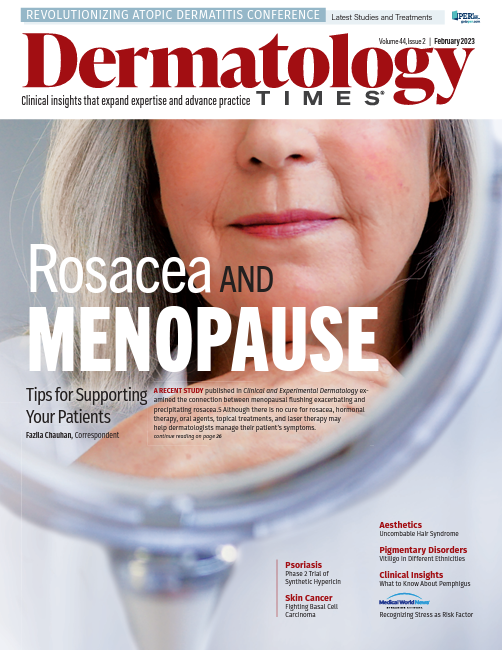- Case-Based Roundtable
- General Dermatology
- Eczema
- Chronic Hand Eczema
- Alopecia
- Aesthetics
- Vitiligo
- COVID-19
- Actinic Keratosis
- Precision Medicine and Biologics
- Rare Disease
- Wound Care
- Rosacea
- Psoriasis
- Psoriatic Arthritis
- Atopic Dermatitis
- Melasma
- NP and PA
- Skin Cancer
- Hidradenitis Suppurativa
- Drug Watch
- Pigmentary Disorders
- Acne
- Pediatric Dermatology
- Practice Management
- Prurigo Nodularis
- Buy-and-Bill
Publication
Article
Dermatology Times
The Art of Smelling Good
Author(s):
In this month's Cosmetic Conundrums column, Zoe Diana Draelos, MD, discusses fragrances in skin care products.
The scenting of the body is an ancient tradition, and there is evidence of the first perfume factory in Pyrgos, Cyprus, manufacturing scents from herbs and oils in 2000 BCE. Here are some commonly asked questions about the use of fragrances in skin care products today.
Q: Why do skin care product manufacturers use fragrances when fragrances may be an allergen or irritant for some individuals?
There is a strong link between smell and human emotion, and some of the earliest memories of children revolve around scent. Thus, the pleasant aroma of a skin care product can evoke positive feelings for the user. In addition, many skin care products would have unpleasant smells without the use of masking fragrances. Although fragrance is among the most expensive ingredients in skin care products, manufacturers have discovered that its benefits outweigh its drawbacks.
Q: Why does the smell of a skin care product change over time?
Fragrances are designed to be volatile, and heir volatility determines how long their smell will last as well as how it will smell. The ingredients include low molecular weight aromatic molecules that are divided into top, middle, and base notes. Top notes are the most volatile and provide an immediate aroma as soon as a product is opened, but they quickly dissipate. Middle notes are less volatile and account for most of a product’s scent. Base notes are the least volatile and provide the longest-lasting smell. Thus, the fragrance changes as its ingredients are wicked away into the air.
Q: Why do some scents last a long time and others only minutes?
Fragrances can be said to have 1 of 3 methods of release: delayed, sustained, or burst.
Delayed release is a controlled technique whereby the scent is released after application. Sustained release maintains a constant fragrance level over time, and this method is used for most perfumes. Burst release is rapid and fleeting release of the fragrance and is used for shampoos and spray formulations. These controlled releases can be accomplished via encapsulation, in which the scent is surrounded with a layer of material that prevents release until desired. Release can be activated by an increase in body temperature, a change in skin pH, or contact with sweat.
Q: Does scent affect our perception of product performance?
Absolutely! Consumers repeatedly state that products that “smell right” work better. For example, dandruff shampoos are fragranced to smell slightly medicinal instead of boldly floral to reinforce our impression of therapeutic value. Baby shampoos, on the other hand, are very lightly scented to underscore that they are mild to skin and eyes. Fragrances are also used to reinforce ingredients. For example, a cocoa butter hand cream is scented to smell like cocoa, while an apple pectin shampoo will be scented like green apples. The imagery produced by the fragrance reinforces efficacy in the consumer’s mind.
Q: Is fragrance material sustainable or does it deplete natural sources?
Fragrance components are becoming increasingly synthetic. Organic chemists now perform “head-space analyses” in which they examine the air above flowering plants to more accurately mimic fragrances in the lab. Synthesized fragrances are less expensive, less allergenic, and more sustainable. Common ingredients that are synthetically derived include vanillin, musk ketone, citronellol, and hexyl cinnamic aldehyde.
Q: What about “unscented” skin care products? Are unscented products suitable for patients with fragrance allergies?
Unscented products contain a masking fragrance and, therefore, are not fragrance free and may not be suitable for individuals with fragrance allergies. Masking fragrance is designed to blend with the natural odor of a formulation in attempt to offset poor smell. Unscented formulations typically possess minimal aroma and are intended for use in combination with strongly scented products. For example, a body wash may be unscented with the idea that that the user will subsequently apply a fragranced body lotion. Thus, unscented products eliminate fragrance combinations that might interfere with one another to create an unpleasant smell.
Zoe Diana Draelos, MD, is an adjunct assistant professor of dermatology at Duke University School of Medicine in Durham, North Carolina, and chief medical editor of Dermatology Times®.






